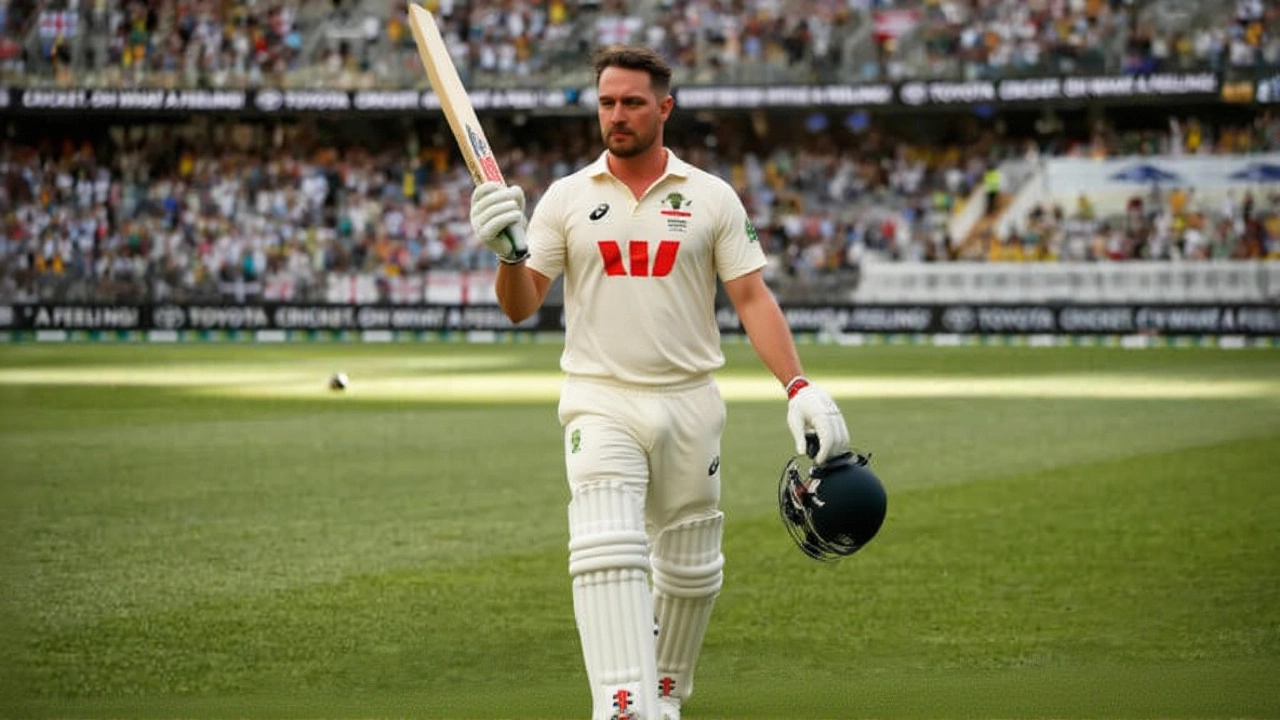Travis Head's 69-ball century powers Australia to historic two-day Ashes win in Perth
 Nov, 23 2025
Nov, 23 2025
Travis Head didn’t just bat—he detonated. On November 22, 2025, the 31-year-old Australian opener smashed the fastest century by an Australian in Ashes history on home soil, tearing through England’s attack in just 69 balls at Perth Stadium. The innings didn’t just win the match—it rewrote the script of the Ashes, giving Australia a 1-0 lead in the five-Test series and moving them within touching distance of retaining the iconic urn first contested in 1882. What made it more remarkable? Head was moved to the top of the order at the last minute to cover for the injured Usman Khawaja. The gamble? A masterstroke.
How a 69-ball storm changed the Ashes
By the 116th second of his innings, Head had cracked three boundaries in three balls off Ben Stokes, England’s captain and the architect of the aggressive ‘Bazball’ philosophy. At 130 seconds, he slammed four boundaries in a single over. The crowd roared. The scoreboard blinked. The English bowlers looked stunned. At 213 seconds, Head brought up his century with a six—short, sharp, and devastatingly sweet. Cricket.com.au’s live transcript captured it best: ‘short 69 balls but oh so sweet for Travis Head.’
It wasn’t just power. It was precision. Commentary noted how he ‘saw this like a football’—reading line and length like a quarterback reading a defense. At 22 seconds, analysts remarked: ‘That’s why he’s so valuable. He knows how to pounce on an opponent.’ He didn’t just score runs—he broke England’s rhythm, disrupted their plans, and forced them into reactive mode. His innings was the antithesis of the slow-burn Test cricket England had championed under Stokes. It was a hurricane in a world of drizzle.
Strategic substitution, massive payoff
Head wasn’t even supposed to open. With Usman Khawaja sidelined, Australia’s coach, Andrew McDonald, made a bold call: promote Head, the aggressive middle-order dynamo, to opener. It was a risk. Openers face the new ball, the swing, the pressure. Head had opened only twice in Test cricket before this match. Neither had gone well.
This time, he turned pressure into poetry. His 100 came off 69 balls—three fewer than Adam Gilchrist’s previous record of 71 in 2006. It was the fastest by any Australian opener in Ashes history on Australian soil. The numbers don’t lie: 14 fours, 6 sixes, strike rate of 144.92. And crucially, he did it against a side that had won six of its last seven Tests under ‘Bazball.’

England’s shock, Australia’s surge
For England, it was a nightmare. England and Wales Cricket Board (ECB) admitted in its post-match analysis that Head’s innings had ‘completely disrupted’ their bowling strategy. Stokes, who had taken 11 wickets in the first Test, conceded 24 runs in the over where Head smashed four boundaries. The scoreboard pressure forced England into defensive field placements, and Head exploited every gap.
Meanwhile, Cricket Australia celebrated not just the win, but the message it sent. CEO Nick Hockley, speaking at a press conference on November 23, 2025, said: ‘Travis Head’s innings wasn’t just about the runs scored; it was a tactical masterstroke that exposed vulnerabilities in England’s much-lauded Bazball approach.’
The Australian Cricketers' Association echoed that sentiment, calling it an ‘exceptional demonstration of aggressive yet controlled batting under immense pressure.’ Even 9 News Australia captured the national mood: ‘teammates in awe, England in shock, and moved the Aussies a step closer to retaining the urn.’
What comes next? The Melbourne showdown
The next chapter begins on December 26, 2025, at the Melbourne Cricket Ground. The second Test in Perth was a statement. The third in Melbourne will be a test of character. Can Australia sustain this momentum? Can England recover their composure? The Ashes urn—weighing just 3.5 pounds but carrying 143 years of history—now leans heavily in Australia’s favor.
With the series tied 0-0 after the first Test, Head’s blitz turned the tide. Australia now needs just one more win to retain the Ashes, regardless of the final result. That’s how much weight this innings carried. And with the MCG’s large boundaries and traditionally spin-friendly pitch, England’s options are narrowing. Will they tweak their batting order? Bring in a specialist spinner? Or double down on Bazball and risk another collapse?

Why this matters beyond the scoreboard
This wasn’t just another century. It was a cultural reset. For years, England’s ‘Bazball’—named after Stokes—was hailed as the future of Test cricket: fast, fearless, fun. But Head showed that aggression doesn’t have to mean recklessness. His innings was controlled chaos. He didn’t swing wildly—he picked his moments. He didn’t just attack—he dismantled.
It also proved the value of adaptability. In a sport where tradition often trumps innovation, Australia’s decision to move Head up the order wasn’t just tactical—it was visionary. It showed that modern Test cricket isn’t about rigid roles. It’s about using your best players in the best positions, even if it breaks the mold.
And for fans? It was a reminder that Test cricket can still thrill. That a single innings can turn a series on its head. That sometimes, the most beautiful things come in the shortest bursts.
Frequently Asked Questions
How does Travis Head’s 69-ball century compare to other Ashes centuries?
Head’s 100 off 69 balls is the fastest by an Australian opener in Ashes history on home soil, surpassing Adam Gilchrist’s 71-ball century in 2006. Globally, it ranks among the top five fastest Test centuries in Ashes history. Only two players—Viv Richards (56 balls in 1986) and Brendon McCullum (54 balls in 2015)—have reached a century faster in Test cricket overall. But Head’s came against a top-ranked England side, under immense pressure, making it one of the most significant in the rivalry’s 143-year history.
Why was Travis Head moved to opener, and was this a common strategy?
Head was promoted to opener to replace the injured Usman Khawaja, who had opened in the first Test. While Head had only opened twice before in Tests, Australia’s coach Andrew McDonald prioritized match-winning aggression over traditional roles. This isn’t common in Ashes cricket—openers are usually specialists—but it’s becoming more frequent in modern Test cricket as teams prioritize match impact over positional rigidity. The gamble paid off spectacularly.
What impact did Head’s innings have on England’s Bazball strategy?
England’s Bazball approach relies on constant pressure and high scoring rates to force opponents into mistakes. But Head’s innings exposed a flaw: when one batsman dominates, the pressure flips. His ability to score quickly without losing wickets neutralized England’s aggressive field settings and left their bowlers demoralized. The ECB admitted his innings ‘completely disrupted’ their game plan, particularly against Ben Stokes, who conceded 24 runs in one over. Bazball needs momentum; Head stole it.
What are Australia’s chances of retaining the Ashes now?
With a 1-0 lead after two Tests, Australia only needs one more win to retain the Ashes, regardless of the final series result. The next Test in Melbourne starts December 26, 2025. If Australia wins there, they retain the urn with two matches still to play. Even if they draw the next three, they still retain the Ashes. The pressure is now squarely on England to win at least three of the remaining four Tests—a tall order after Head’s masterclass.
Is this the fastest century ever in Test cricket?
No, but it’s among the fastest. The fastest Test century is Brendon McCullum’s 54-ball ton for New Zealand against Australia in 2015. Viv Richards holds the second-fastest at 56 balls. Head’s 69-ball century is the fastest by an Australian opener in Ashes history and the fastest on Australian soil since the 1990s. It’s not the record—but in the context of the Ashes, it might be the most impactful.
Who else played key roles in Australia’s victory?
While Head stole the headlines, captain Pat Cummins led the bowling attack with precision, taking 3 wickets in England’s second innings. All-rounder Cameron Green contributed a vital 42 in the first innings, and spinner Nathan Lyon took 4 wickets on a pitch that offered little turn. But without Head’s explosion, Australia wouldn’t have had the platform to force the win within two days. He was the catalyst.
